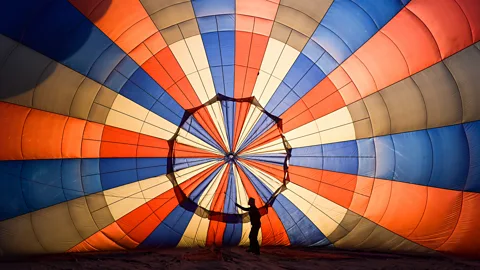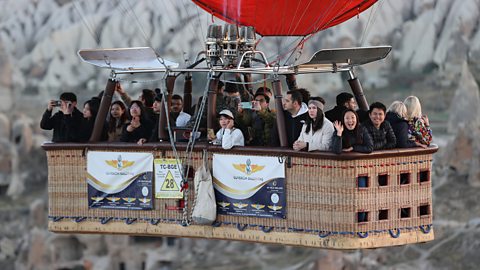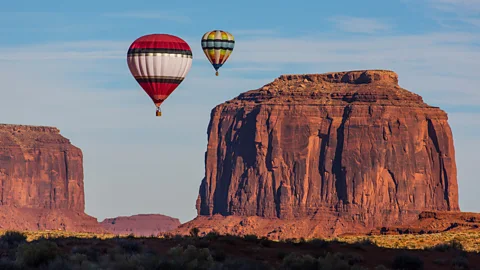How safe are hot air balloons? What to know before taking to the clouds
 Getty Images
Getty ImagesWhen it comes to adventure-seeking, there is always risk involved. But hot air balloon rides are rarely fatal. Here’s how travellers can prepare for safety and enjoyment.
According to a news release, the crash happened around 07:50. in Eloy, about 105km south of Phoenix. The balloon, operated by Droplyne Hot Air Balloon Rides, was carrying 13 people, including eight skydivers, four passengers and the pilot. The skydivers completed their planned jump from the balloon before any issues emerged. Soon after, "something catastrophic occurred with the balloon, causing it to crash to the ground," Eloy Police Chief Byron Gwaltney said at a news conference.
Hot air balloon excursions have grown in popularity in recent years. There are hubs all over the world where riders take to the skies. Wadi Rum, Jordan, is known for lighting up the desert with colourful hot air balloons. In Cappadocia, Turkey, it's one of the most popular things to do, and hundreds of balloons fly every single day. Albuquerque, New Mexico Balloon Fiesta is the biggest balloon event of the year in the US. The global market is booming and is expected to grow from £288 ($366M) to £444 ($540M) by 20230. It's easy to spot that the trend is on the rise, especially on social media. The tag #hotairballoon has over 2.5 million usages on Instagram alone.
In the wake of the tragedy, adventurers planning on taking a hot air balloon ride may wonder how safe these "bucket list" trips actually are – and how to prepare for an adventure that’s both safe and enjoyable.
 Getty Images
Getty ImagesAre hot air balloons safe?
The short answer is: yes, far more often than not. Accidents are increasingly rare, but they do happen. Data from 2022 provided by the National Transportation Safety Board shows 775 hot air balloon accidents on record in the United States since 1964, total. Only 70 involved fatalities. Still, a 2013 study also saw an uptick in incidents between 2000 and 2011, as regulations around commercial air balloon flying seemed to be relaxing. "The inverse relationship between crash rates and oversight raises concerns about the public health impact of less-regulated commercial air tour operations, such as paid hot-air balloon rides," the study authors warned in the report.
With the pastime's popularity growing, more regulations could follow. After a 2016 crash in Lockhart, Texas killed 16 people when a hot air balloon crashed into power lines and caught fire, it prompted the Federal Aviation Administration (FAA) to take new steps to make the adventure safer. Working with the Balloon Federation Of America, the "Envelope of Safety", a new accreditation programme, was developed. To meet the requirements, pilots would need to be commercially certified for at least 18 months to carry more than 4-6 passengers, get recertified to fly every two years and meet other qualifications. Droplyne Hot Air Balloons participates in the programme.
In 2022, the FAA went even further, adopting a new rule that requires hot air balloon pilots to hold medical certificates when flying paying passengers — the same that other commercial pilots hold. Tammy Jones, an FAA spokesperson explained in an email, "Hot air balloons must follow the same regulations as other types of aircraft." While the FAA doesn't specify where balloons can take off or land, "they must be operated safely so they don't pose a hazard to people or property on the surface". Jones continued. They also upped the number of training hours pilots would need for certification.
While no mode of air travel comes with zero risk, by comparison, hot air balloons are very safe, statistically speaking. Bruce Byberg, the Northeast Region Director of the Balloon Federation of America, agrees. "Aviation is the safest mode of transportation and balloons are the safest mode of aviation," he wrote in an email. He touts "over 4,000 accident-free" flying hours as a pilot himself, and says he always flies "within the margins of the aircraft manual". While Byberg might be slightly biased in favor of hot air ballooning, statistically, he’s not wrong. According to a 2024 data report by Gitnux, globally, there were less than 30 hot air balloon deaths between 2008 and 2022. Being killed by a shark, a lightning strike or even falling into the Grand Canyon (which, shockingly, leads to about 12 deaths per year) are all more likely.
 Getty Images
Getty ImagesWhat can hot air balloon tourists do to prepare?
Do your research, book with a reputable company – and then, relax. Under the new FAA "Envelope of Safety" guidelines, pilots are screened for drug and alcohol use, and aircrafts are subject to more frequent inspections. This accreditation has three tiers: silver, gold or platinum, with increasingly rigid qualifications. However, operators are not required to be a part of that programme, so it's something to keep in mind when choosing which company to plan an excursion with.
Preparation shouldn't be for the worst when planning a hot air balloon experience. It's also important to dress in layers. Hot air balloon rides can often last hours, meaning it might be much warmer (or colder) upon landing than it was at take off. Because companies often have different rules, travellers planning to fly with family should look for age and health requirements. Most companies don’t allow young children or pregnant women to ride.
While flying amongst the clouds is undeniably a thrill, it's ultimately a fairly safe activity for passengers. Despite the recent tragedy, it's important to remember that all adventures come with some risk. When it comes to hot air balloons, that risk is really quite low.
---
Join more than three million BBC Travel fans by liking us on Facebook, or follow us on Twitter and Instagram.
If you liked this story, sign up for The Essential List newsletter – a handpicked selection of features, videos and can't-miss news delivered to your inbox every Friday.
